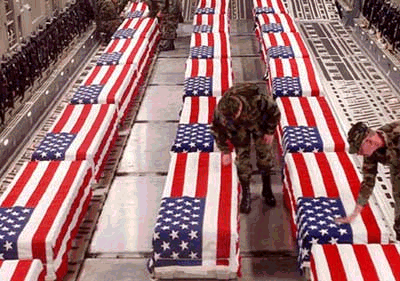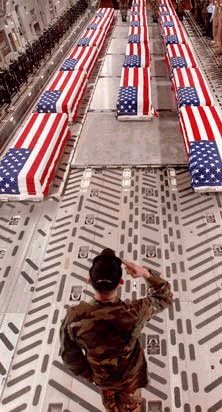
How Our President Honors Those Who Have Been Killed In His Service: He Hides The
Bodies!:
Pictures added to this report by Information Clearing
House
Curtains Ordered for Media Coverage of Returning Coffins
By Dana Milbank
Tuesday, October 21, 2003; Page A23
Since the end of the Vietnam War, presidents have worried that their military actions would lose support once the public glimpsed the remains of U.S. soldiers arriving at air bases in flag-draped caskets.

To this problem, the Bush administration has found a simple solution: It has ended the public dissemination of such images by banning news coverage and photography of dead soldiers' homecomings on all military bases.
In March, on the eve of the Iraq war, a directive arrived from the Pentagon at U.S. military bases. "There will be no arrival ceremonies for, or media coverage of, deceased military personnel returning to or departing from Ramstein [Germany] airbase or Dover [Del.] base, to include interim stops," the Defense Department said, referring to the major ports for the returning remains.
A Pentagon spokeswoman said the military-wide policy actually dates from about November 2000 -- the last days of the Clinton administration -- but it apparently went unheeded and unenforced, as images of caskets returning from the Afghanistan war appeared on television broadcasts and in newspapers until early this year. Though Dover Air Force Base, which has the military's largest mortuary, has had restrictions for 12 years, others "may not have been familiar with the policy," the spokeswoman said. This year, "we've really tried to enforce it."
President Bush's opponents say he is trying to keep the spotlight off the fatalities in Iraq. "This administration manipulates information and takes great care to manage events, and sometimes that goes too far," said Joe Lockhart, who as White House press secretary joined President Bill Clinton at several ceremonies for returning remains. "For them to sit there and make a political decision because this hurts them politically -- I'm outraged."

Pentagon officials deny that. Speaking on condition of anonymity, they said the policy covering the entire military followed a victory over a civil liberties court challenge to the restrictions at Dover and relieves all bases of the difficult logistics of assembling family members and deciding which troops should get which types of ceremonies.
One official said only individual graveside services, open to cameras at the discretion of relatives, give "the full context" of a soldier's sacrifice. "To do it at several stops along the way doesn't tell the full story and isn't representative," the official said.

A White House spokesman said Bush has not attended any memorials or funerals for soldiers killed in action during his presidency as his predecessors had done, although he has met with families of fallen soldiers and has marked the loss of soldiers in Memorial Day and Sept. 11, 2001, remembrances.
The Pentagon has previously acknowledged the effect on public opinion of the grim tableau of caskets being carried from transport planes to hangars or hearses. In 1999, the then-chairman of the Joint Chiefs of Staff, Army Gen. Henry H. Shelton, said a decision to use military force is based in part on whether it will pass "the Dover test," as the public reacts to fatalities.
Ceremonies for arriving coffins, not routine during the Vietnam War, became increasingly common and elaborate later. After U.S. soldiers fell in Beirut, Grenada, Panama, the Balkans, Kenya, Afghanistan and elsewhere, the military often invited in cameras for elaborate ceremonies for the returning remains, at Andrews Air Force Base, Dover, Ramstein and elsewhere -- sometimes with the president attending.
President Jimmy Carter attended ceremonies for troops killed in Pakistan, Egypt and the failed hostage rescue mission in Iran. President Ronald Reagan participated in many memorable ceremonies, including a service at Camp Lejeune in 1983 for 241 Marines killed in Beirut. Among several events at military bases, he went to Andrews in 1985 to pin Purple Hearts to the caskets of marines killed in San Salvador, and, at Mayport Naval Station in Florida in 1987, he eulogized those killed aboard the USS Stark in the Persian Gulf.

During President George H.W. Bush's term, there were ceremonies at Dover and Andrews for Americans killed in Panama, Lebanon and aboard the USS Iowa.
But in early 1991, at the time of the Persian Gulf War, the Pentagon said there would be no more media coverage of coffins returning to Dover, the main arrival point; a year earlier, Bush was angered when television networks showed him giving a news briefing on a split screen with caskets arriving.
But the photos of coffins arriving at Andrews and elsewhere continued to appear through the Clinton administration. In 1996, Dover made an exception to allow filming of Clinton's visit to welcome the 33 caskets with remains from Commerce Secretary Ronald H. Brown's plane crash. In 1998, Clinton went to Andrews to see the coffins of Americans killed in the terrorist bombing in Nairobi. Dover also allowed public distribution of photos of the homecoming caskets after the terrorist attack on the USS Cole in 2000.
The photos of coffins continued for the first two years of the current Bush administration, from Ramstein and other bases. Then, on the eve of the Iraq invasion, word came from the Pentagon that other bases were to adopt Dover's policy of making the arrival ceremonies off limits.
"Whenever we go into a conflict, there's a certain amount of guidance that comes down the pike," said Lt. Olivia Nelson, a spokeswoman for Dover. "It's a consistent policy across the board. Where it used to apply only to Dover, they've now made it very clear it applies to everyone."
© 2003 The Washington Post Company
Join our Daily News Headlines
Email Digest
|
|
Information
Clearing House
Daily News Headlines
Digest
|
HOME
COPYRIGHT NOTICE
|